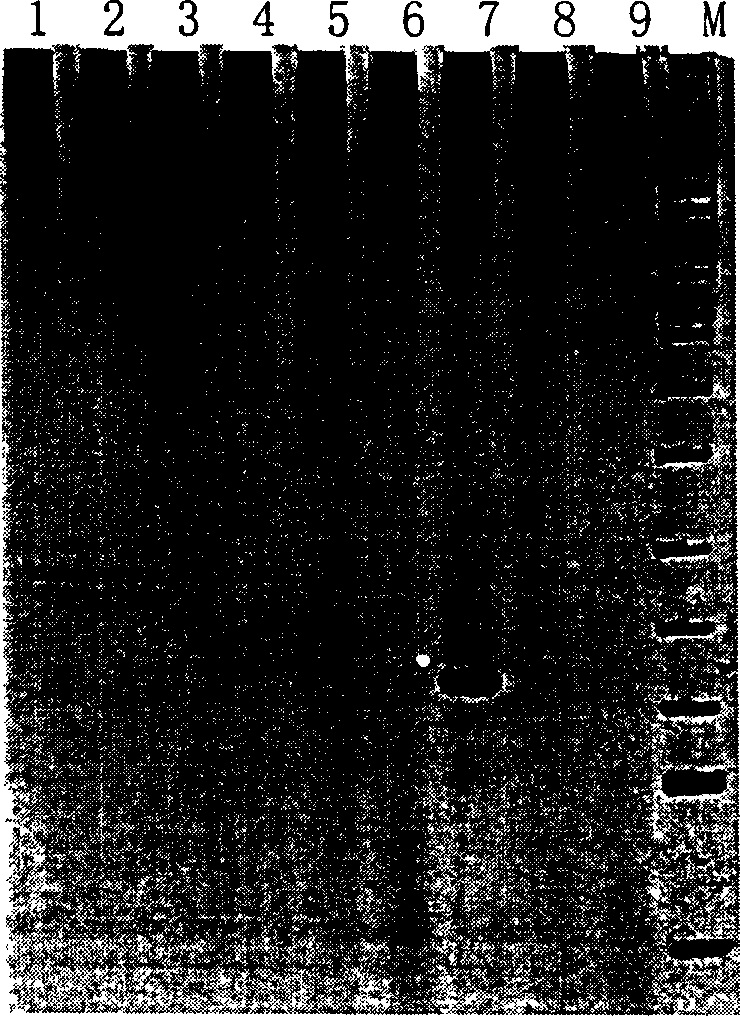Molecule tag in use for identifying strain of Porphyra haitanensis and application
A technology of molecular markers and identification of laver, which is applied to the determination/inspection of microorganisms, biochemical equipment and methods, etc., can solve the problems of difficulty in satisfying the cultivation and production of laver, time-consuming and labor-intensive, and quality decline, so as to shorten the breeding cycle and use Convenience and low detection cost
- Summary
- Abstract
- Description
- Claims
- Application Information
AI Technical Summary
Problems solved by technology
Method used
Image
Examples
Embodiment 1
[0024] Example 1. Identification of the acquisition of AFLP markers for the excellent strains of Porphyra alba
[0025] 1. Materials: See Table 1 for the names and sources of 16 laver samples used in the experiment (stored in the shade at -20°C).
[0026] breed name
source
growing conditions
breed name
source
growing conditions
GL1
Fujian Pingtan
artificial breeding
XSD
Fuqing City, Fujian Province
wild breeding
LSD
Fujian Pingtan
the wild
NH
Fujian Pingtan
the wild
BBD
Fujian Pingtan
the wild
DXY
Fujian Pingtan
wild breeding
breed
JJS
Fujian Pingtan
the wild
LH
Longhai City, Fujian Province
artificial breeding
SYS5
Xiamen University
LPZ
Fujian Pingtan
artificial breeding
NH1 ...
Embodiment 2
[0051] Example 2. Acquisition of excellent strain-specific SCAR markers
[0052] 1. Materials: Laver samples are the same as in Example 1, Escherichia coli DH5α, pMD18-T Vector
[0053] 2. Method:
[0054] 1. Recovery of specific AFLP fragments: According to the obtained AFLP polypropylene gel electrophoresis pattern, look for the specific AFLP marker band of the excellent strain, and cut off the gel containing the band with a sharp blade. The recovered gel pieces were dissolved in 400 μL of high-salt solution (20% ethanol, 1mol / L LiCL and 10mmol / L Tris-HCL, Ph7.5), placed at room temperature for 24 hours, incubated at 65°C for 2 hours, and the DNA was precipitated with absolute ethanol and Dissolve in 20 μL TE.
[0055] 2. PCR re-amplification of specific AFLP fragments: Take 5 μL of recovered DNA as a template, use the same primers as in selective amplification, and amplify for 35 cycles at 94°C for 30S; 56°C for 30S; 72°C for 60S according to the following procedure.
[...
Embodiment 3
[0075] Example 3. PCR primer sequences obtained by SCAR markers
[0076] 1. Method
[0077] Using the SCAR marker sequence of ACA-CAC (203) as a primer design template, primers were designed by Primer 5.0 primer design software.
[0078] 2. Primer Design Principles
[0079] 1. The GC content in the two primers should be as similar as possible;
[0080] 2. Avoid obvious secondary structure inside the primer;
[0081] 3. Avoid complementary sequences between the two primers to avoid the formation of "primer dimers";
[0082] 4. The pairing of primers and target sequence fragments must be precise and strict, especially at the 3' end;
[0083] 5. The specific primer should have a certain annealing temperature (not lower than 50°C) and a certain length (not less than 18 bp).
[0084] 3. Results
[0085] Specific primers were designed according to the SCAR marker sequence, and its sequence is:
[0086] Marker1: 5’-AGT AAA ATG GGG AAC AGC-3’
[0087] Marker2: 5'-ATC GCA GAA T...
PUM
 Login to View More
Login to View More Abstract
Description
Claims
Application Information
 Login to View More
Login to View More - R&D
- Intellectual Property
- Life Sciences
- Materials
- Tech Scout
- Unparalleled Data Quality
- Higher Quality Content
- 60% Fewer Hallucinations
Browse by: Latest US Patents, China's latest patents, Technical Efficacy Thesaurus, Application Domain, Technology Topic, Popular Technical Reports.
© 2025 PatSnap. All rights reserved.Legal|Privacy policy|Modern Slavery Act Transparency Statement|Sitemap|About US| Contact US: help@patsnap.com

